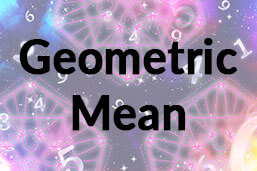
The geometric mean is a critical mathematical concept, mainly used in fields like statistics and geometry, offering an alternative perspective on averages compared to the more commonly known arithmetic mean. Unlike the arithmetic mean, the geometric mean multiplies all values together and then takes the nth root. This approach is particularly useful when dealing with quantities that increase or decrease exponentially, such as growth rates and ratios. Understanding the geometric mean is imperative for interpreting data accurately and serves as a foundational tool for more advanced statistical models.
Definition: Geometric mean
When you take the square root of the product of a set of numbers, you get the GM, which is the average value or mean that characterizes the central tendency of the numbers in the collection. The process is simple:
- Multiply all the values by n and extract the nth root of the resulting integers.
- If we take any two integers, say 8 and 1, their geometric mean will be:
Therefore, the nth root of the product of n integers may be considered the geometric mean. Take into consideration that this is not the same as the arithmetic mean.
To calculate the arithmetic mean, we sum up all the numbers in the data and divide them by the total. However, in geometric mean, you multiply the provided data values by the radical index and then take root to get the complete outcome of data values.
Take the square root if you have two data points, the cube root if you have three, the fourth root if you have four, and so on, as the number of data points increases.
Geometric mean: Formula
If there are n observations in a data collection, the GM is calculated as the nth root of the product of the numbers. Let’s say we’re trying to get the geometric mean of a set of observations, and those observations are denoted by the letters ,
…,
. The formula to determine the geometric mean is provided below:
or
Alternative representations include:
or
whereby n= the total number of terms that are multiplied.
Taking logarithms on both sides:
Therefore, the geometric mean =
Geometric mean: Calculation
The geometric mean is found by performing two basic operations:
- Add up all the numbers to see what they multiply.
- Discover the nth root of the sum (n is the total number of values).
It is important to keep in mind the following before trying to calculate this central tendency indicator:
- Only positive numbers will do if you are looking for the GM.
- The GM will be 0 if any numbers in the data set are zero.
In Excel, “=GEOMEAN” is the keyboard shortcut for determining the geometric mean. To compute the GM of a set of numbers, insert the expression into a cell and then specify the cells or numbers that include those values.
Geometric mean: Example with varying values
Two machines are compared in terms of performance across three distinct tasks and evaluation criteria. Calculating the geometric and arithmetic means of each machine’s process rating scores yields an estimate of its average efficiency.
Geometric mean of machine X
Step 1:
To obtain their product, multiply all of the values together. In this case, the sum is:
Step 2:
Determine the nth root of the product, where n is the number of possible values.
Geometric mean of machine Y
Step 1:
Multiply the values given to get the product. In this example, the sum is:
Step 2:
Determine the nth root of the product, where n is the number of possible values.
Geometric mean: Example with percentage
You are curious about the average voter turnout in the last five U.S. elections and have obtained the following information.
Step 1:
Multiply the values together and get the product:
Step 2:
Find the nth root of the product:
Across the last five U.S. elections, the average voter participation has been 54.64 percent.
Geometric mean vs. Arithmetic mean
When illustrating percentage change over time or compound interest, the GM outperforms the arithmetic mean. You may now use mathematical and geometric comparisons from the examples above to find the most efficient machines between X and Y.
| Arithmetic Mean | Geometric Mean | |
| Machine X | 729 | 105.55 |
| Machine Y | 815.67 | 87.18 |
Even if Machine X has a better efficiency according to the arithmetic means, Machine Y has a higher efficiency according to the geometric means. Because the arithmetic mean is inclined toward larger numbers than the vast majority of your data, the geometric mean is a better approximation.
When to use the geometric mean
The geometric mean provides more reliable results for data or percentages that are favorably skewed than the more popular arithmetic mean. There is a concentration of lower scores and a more dispersed right tail in a positively skewed distribution.
Some examples of skewed statistics include the distribution of income. In a positively skewed dataset, most values are often rather low, but a few extremely high values or outliers may skew the arithmetic mean to the right.
The GM is often less than the arithmetic mean, so it is a more accurate representation of smaller numbers. Geometric mean assumes that variables cannot take on negative values and always have a genuine zero. It works best for comparing ratios. Any negative percentage shifts must be couched in a positive light.
FAQs
The GM is used when calculating an average since it multiplies all numbers to determine their root.
The arithmetic mean, commonly known as “the mean,” is the most used measure of central tendency. The geometric mean uses multiplication and finding the root of numbers to conclude, while the arithmetic means averages them.
No, it’s impossible to compute the geometric mean for a set that contains negative values.
The data collection’s average or median may be determined using central tendency measures. The mean, median, and mode are the three most prevalent indicators of central tendency.

